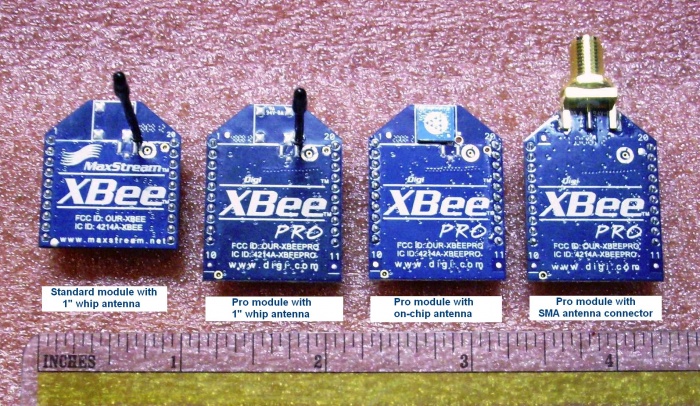Ren-W Antenna Info
Overview
- An XBee radio module needs an antenna to be able to transmit and receive data. Depending on the type of XBee in use, the antenna may be one that is built into the radio or instead, the radio may have an antenna connector so that it may be connected to an external antenna. The examples below show the 1" whip antenna, the on-chip antenna and the XBee with an RPSMA connector, or shortened to the "sma" version of the XBee for connecting to standard Wi-Fi antennas. Not shown is the Xbee radio with the U.FL. connector which is a tiny, snap-on connector on the top of the XBee module for connecting a short U.FL. cable that has an RPSMA connector on the other end.
- The type XBee module as well as the type of antenna chosen makes a difference in terms of distance performance, as noted in the following chart from the manufacturer's documentation:
Radiation Patterns
- An additional consideration is the radiation patterns for the various types of antennas, from left-to-right, on built-in 1" whip antenna, the on-chip antenna and an external antenna:
- In actual testing over short distances any of the antennas have proven to be adequate but if either very long or wide-area coverage is desired, the obvious choice is to use an external antenna.
Transmission Power Losses/Gains
- The purest environment for the best wireless communication between to devices is where there is a direct line-of-sight distance between the transmitting antenna and the receiving antenna and there is nothing but air between the two. Trees, houses, cars, bushes, rain, plastic -- anything that is physically between the transmitting and receiving antenna will degrade the performance in some way, and it is impossible to know exactly what the effect will be without trying it. There is no formula that says a tree is worth X amount or a house is worth Y amount, because not all trees or houses are alike. LIkewise, it's impossible to know exactly what effect putting the antenna inside a plastic box will have verses using an external antenna on the outside of the box except to say that an antenna outside the box will be more efficient than one inside the box because the plastic will have an effect.
- Another element that can degrade the transmission of a radio wave is the antenna cable between the transmitter (the XBee radio module itself) and its antenna. Both the length and type of cable have an effect on the transmitted power because the cable itself absorbs some of the energy. Obviously, the longer the cable, the more it will absorb. Therefore, one of the main objectives is to keep an antenna cable as short as is practical given the relative locations of the XBee radio module and its antenna. Obviously, the built-in 1" whip antenna gives such good performance because there is virtually no power loss in a cable because there isn't one! But when it comes to external antennas, cable length can become a factor.
- One way to help reclaim some of the transmitting power lost by an antenna cable is to use a high-gain wi-fi antenna. Because the XBee radio operates in the 2.4ghz spectrum, common wi-fi antennas can be used as external antennas and such antennas come in many flavors, lengths, and "gain" values. Gain values are typically measured in "dbi" or "db" numbers so that an antenna that is touted as having 6db gain would theoretically provide better performance than an antenna with only 3db gain, and in fact, 6db would be approximately twice the gain as 3db.
- An antenna with 3db gain is roughly equivalent to doubling the transmission power that arrives at the antenna connector. Therefore, if an antenna cable was so long that it absorbed 50% of the power, using a 3db gain antenna would roughly double the transmitting power of the remaining 50% power back up to 100%. Using an antenna with 6db, 9db or even a greater gain value could perhaps work even better, at least theoretically. But there comes a point of diminishing returns with matching antenna cable length and antenna gain -- it's still best to keep the cable as short as possible.
Antenna Position and Orientation
- There's a reason why television and radio stations have their antennas mounted atop high poles: a high pole provides for longer line-of-sight distance. Therefore, it's logical to say that if your antenna is on the ground, it probably won't perform as well as if it were mounted six or ten feet off the ground.
- The orientation of the antenna to the ground is also important because radio waves emit outward from the antenna's radiating element. One of the weakest points is the tip: aiming with the tip of an antenna generally yields poor results because not much is emitted from the tip. The best transmission/reception combination is when the transmitting and receiving antennas are parallel to one another. If the tranmitting antenna is vertical to the ground, the receiving antenna should be vertical to the ground, too. Therefore, if you require long distance, you'll want to pay attention to the orientation of the antenna to ensure efficient communication.
Getting Practical
Additional Ren-W Links




